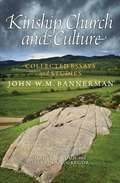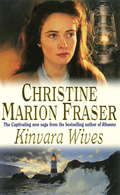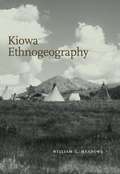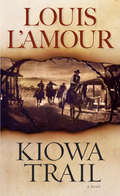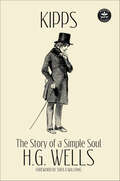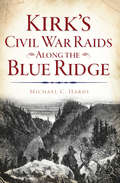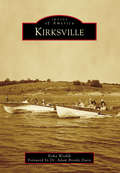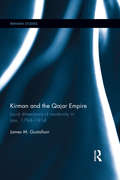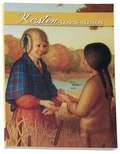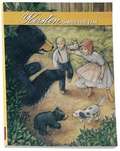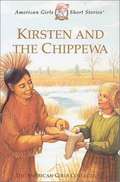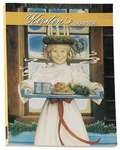- Table View
- List View
Kinship, Capitalism, Change: The Informal Economy of the Navajo, 1868-1995 (Native Americans: Interdisciplinary Perspectives)
by Michael J. FrancisconiFirst Published in 1998. Routledge is an imprint of Taylor & Francis, an informa company.
Kinship, Church and Culture: Collected Essays and Studies by John W. M. Bannerman
by John W. BannermanA collection of the author&’s essays and studies on the Gaelic roots of Scotland. John Bannerman (1932-2008) saw the history of Scotland from a Gaelic perspective, and his outstanding scholarship made that perspective impossible to ignore. As a historian, his natural home was the era between the Romans and the twelfth century when the Scottish kingdom first began to take shape, but he also wrote extensively on the MacDonald Lordship of the Isles in the fourteenth and fifteenth centuries, while his work on the Beatons, the notable Gaelic medical kindred, reached into the early eighteenth century. Across this long millennium, Bannerman ranged and wrote with authority and insight on what he termed the &“kin-based society,&” with special emphasis upon its church and culture, and its relationship with Ireland. This collection opens with Bannerman&’s ground-breaking and hugely influential edition and discussion of Senchus fer nAlban (&“The History of the Men of Scotland&”), which featured in his Studies in the History of Dalriada (1974), now long out of print. Also included are all of his published essays, plus an essay-length study of the Lordship of the Isles, which first featured as an appendix in Late Medieval Monumental Sculpture in the West Highlands (1977). The book will be of interest to anyone wanting to know more about the Gaelic dimension to Scotland&’s past and present.&“A substantial, weighty tome, worth every penny of its price. Determination, earnestness, humor, and originality characterize all this work. A substantial intellectual treat brought gully into the scholarly light of day for a new generation.&” —Cambrian Medieval Celtic Studies
Kinsmen of Another Kind: Dakota-White Relations in the Upper Mississippi Valley 1650-1862
by Gary C. AndersonIn August 1862, the Dakota of Eastern Sioux resorted to armed conflict against the white settlers of southern Minnesota. This study uses an ethnohistorical approach to explain why the bonds of peace between the Dakota and the whites were suddenly broken. It shows how the Dakota concept of kinsmen affected the tribe's complex relationships with the whites. The Dakota were obliged to help their relatives by any means possible. Traders who were adopted or married into the tribe gained from this relationship, but had reciprocal responsibilities. After the 1820s, the trade in furs declined, more whites moved into the territory, and the Dakota became more economically dependent on the whites. When American officials and traders failed to fulfill their obligations, many Dakotas finally saw the whites as enemies to be driven from Minnesota. This edition includes a new introduction by the author, who comments on scholarly developments in the field of ethnohistory in the 19th century.
Kintu
by Jennifer Nansubuga MakumbiIn this epic tale of fate, fortune and legacy, Jennifer Makumbi vibrantly brings to life this corner of Africa and this colourful family as she reimagines the history of Uganda through the cursed bloodline of the Kintu clan. <P><P>The year is 1750. Kintu Kidda sets out for the capital to pledge allegiance to the new leader of the Buganda kingdom. Along the way he unleashes a curse that will plague his family for generations. Blending oral tradition, myth, folktale and history, Makumbi weaves together the stories of Kintu&’s descendants as they seek to break free from the burden of their past to produce a majestic tale of clan and country – a modern classic.
Kinvara
by Christine Marion FraserIt is December 1922, and the keepers of the Kinvara Light, an impressive lighthouse just off the rugged west coast of Scotland, are home for Christmas after three bleak months away from their families. Robert Sutherland, deputy head keeper, finds little comfort at home: his wife Hannah is embittered by her isolation, by the tragedy of her infant son's cerebral palsy and by her husband's long absences. Rob find solace in the arms of Morna Jean Sommero, whose warmth and love compensate for his sterile marriage.Christine Marion Fraser has created a vivid Scottish village and peopled it with memorable characters. The spirited and engaging folk of Kinvara, whose fates are shaped by the harsh landscape and the rugged coast on which they live, will move, entrance, and linger in the memory.'Christine Marion Fraser writes characters so real they almost leap out of the page...you would swear she must have grown up with them' Sun
Kinvara
by Christine Marion FraserIt is December 1922, and the keepers of the Kinvara Light, an impressive lighthouse just off the rugged west coast of Scotland, are home for Christmas after three bleak months away from their families. Robert Sutherland, deputy head keeper, finds little comfort at home: his wife Hannah is embittered by her isolation, by the tragedy of her infant son's cerebral palsy and by her husband's long absences. Rob find solace in the arms of Morna Jean Sommero, whose warmth and love compensate for his sterile marriage.Christine Marion Fraser has created a vivid Scottish village and peopled it with memorable characters. The spirited and engaging folk of Kinvara, whose fates are shaped by the harsh landscape and the rugged coast on which they live, will move, entrance, and linger in the memory.'Christine Marion Fraser writes characters so real they almost leap out of the page...you would swear she must have grown up with them' Sun
Kinvara Affairs
by Christine Marion FraserIt is 1936 and the children of Kinvara are growing up fast. Vaila Sutherland, a born romantic, vows she will never marry until she finds a love as deep as her father's for her mother. Two young men make a play for her heart - will she choose the right one?Andy Sutherland, Vaila's half brother, finds new doors opening despite the cerebral palsy that he has suffered since birth; while nine-year-old Essie, the joy of her mother's life, revels in a world of make-believe and wonder. Cruel Joshua Bowman continues his reign of terror but, as they grow up, his children find ways of thwarting his wishes. When Miriam, too, at last defies him, it has tragic consequences.Heartbreak and horror mingle with tears of joy and, as always, the villagers fight and laugh their way through this enchanting novel, adding many colourful contributions in their unique and inimitable way.'Christine Marion Fraser writes characters so real they almost leap out of the page...you would swear she must have grown up with them' Sun
Kinvara Affairs
by Christine Marion FraserIt is 1936 and the children of Kinvara are growing up fast. Vaila Sutherland, a born romantic, vows she will never marry until she finds a love as deep as her father's for her mother. Two young men make a play for her heart - will she choose the right one?Andy Sutherland, Vaila's half brother, finds new doors opening despite the cerebral palsy that he has suffered since birth; while nine-year-old Essie, the joy of her mother's life, revels in a world of make-believe and wonder. Cruel Joshua Bowman continues his reign of terror but, as they grow up, his children find ways of thwarting his wishes. When Miriam, too, at last defies him, it has tragic consequences.Heartbreak and horror mingle with tears of joy and, as always, the villagers fight and laugh their way through this enchanting novel, adding many colourful contributions in their unique and inimitable way.'Christine Marion Fraser writes characters so real they almost leap out of the page...you would swear she must have grown up with them' Sun
Kinvara Summer
by Christine Marion FraserIt is 1931 and the villagers of Kinvara are welcoming newcomers into their close-knit community. Schoolteacher Catherine Dunbar takes a great interest in the welfare and education of Andy Sutherland, who has cerebral palsy - and comes to have more than a passing interest in his father, Rob. Joshua Bowman is a less popular arrival, as he tries to force his strict principles and beliefs on his neighbours; and his wife Miriam - a native of Kinvara - has a dramatic effect on Johnny Lonely, to whom she was once married.But it is mainly on the children of Kinvara that the novel focuses, as they delight in the freedom and adventure of the beautiful coastal area, and grapple with the first stirrings of young and innocent love.'Christine Marion Fraser writes characters so real they almost leap out of the page...you would swear she must have grown up with them' Sun
Kinvara Summer
by Christine Marion FraserIt is 1931 and the villagers of Kinvara are welcoming newcomers into their close-knit community. Schoolteacher Catherine Dunbar takes a great interest in the welfare and education of Andy Sutherland, who has cerebral palsy - and comes to have more than a passing interest in his father, Rob. Joshua Bowman is a less popular arrival, as he tries to force his strict principles and beliefs on his neighbours; and his wife Miriam - a native of Kinvara - has a dramatic effect on Johnny Lonely, to whom she was once married.But it is mainly on the children of Kinvara that the novel focuses, as they delight in the freedom and adventure of the beautiful coastal area, and grapple with the first stirrings of young and innocent love.'Christine Marion Fraser writes characters so real they almost leap out of the page...you would swear she must have grown up with them' Sun
Kinvara Wives
by Christine Marion FraserStill wounded by her husband's affair with Morna Jean Sommero - an affair ended only by Morna Jean's tragically early death - Hannah Sutherland struggles to make a life for herself in Kinvara's close-knit community. At least she is coming to terms with the fact that her son, Andy, suffers from cerebral palsy, and is learning to love the boy despite his disability. The rugged beauty of the coast is a comfort and solace to Hannah, but can she reconcile herself to the fact that to Rob, she's always been second best and probably always would be.'Christine Marion Fraser writes characters so real they almost leap off the page...you would swear she must have grown up with them' Sun
Kinvara Wives
by Christine Marion FraserStill wounded by her husband's affair with Morna Jean Sommero - an affair ended only by Morna Jean's tragically early death - Hannah Sutherland struggles to make a life for herself in Kinvara's close-knit community. At least she is coming to terms with the fact that her son, Andy, suffers from cerebral palsy, and is learning to love the boy despite his disability. The rugged beauty of the coast is a comfort and solace to Hannah, but can she reconcile herself to the fact that to Rob, she's always been second best and probably always would be.'Christine Marion Fraser writes characters so real they almost leap off the page...you would swear she must have grown up with them' Sun
Kiowa County
by Kiowa County Historical Society Project, Eads High School Local HistoryCarved out of Bent County in 1889, Kiowa County is a rural, agricultural area with a rich and varied history. Located in southeastern Colorado in the heart of the Great Plains, Kiowa County was originally dominated by cattle ranches; however, farming quickly became just as important. The construction of the Missouri Pacific Railroad in the late 1880s sparked the growth of towns in Kiowa County, bringing a variety of ambitious settlers facing many challenges. Confronted with a well-documented drought cycle in the semiarid climate, the settlers persevered to establish schools and businesses and to create homes. Although Kiowa County never became home to a booming metropolis as early residents dreamed, the county's citizens take pride in a rich history and strive to preserve it.
Kiowa Ethnogeography
by William C. MeadowsExamining the place names, geographical knowledge, and cultural associations of the Kiowa from the earliest recorded sources to the present, Kiowa Ethnogeography is the most in-depth study of its kind in the realm of Plains Indian tribal analysis. Linking geography to political and social changes, William Meadows applies a chronological approach that demonstrates a cultural evolution within the Kiowa community. Preserved in both linguistic and cartographic forms, the concepts of place, homeland, intertribal sharing of land, religious practice, and other aspects of Kiowa life are clarified in detail. Native religious relationships to land (termed "geosacred" by the author) are carefully documented as well. Meadows also provides analysis of the only known extant Kiowa map of Black Goose, its unique pictographic place labels, and its relationship to reservation-era land policies. Additional coverage of rivers, lakes, and military forts makes this a remarkably comprehensive and illuminating guide.
Kiowa Trail
by Louis L'AmourKate Lundy, owner of the Tumbling B, and Conn Dury, her foreman, told Tom the rules: men from the cattle drives are forbidden on the north side of town. People appreciated the money the cowboys spent but thought them too coarse to be near their homes. Enticed to come calling by Linda McDonald, daughter of one of the leading citizens, Tom Lundy broke the law and crossed the line. Later that night, he was dead. Outraged by her brother's murder, Kate vows to destroy the entire town. But when Aaron McDonald sends east for an army of hired guns, Conn Dury and the men of the Tumbling B soon wonder if the price of Kate's revenge is too high.From the Paperback edition.
Kipps: The Story of a Simple Soul
by H.G. WellsThe most successful mainstream novel of H.G. Wells, now finally back in print. Kipps The Story of a Simple Soul Until he reached manhood, it was not clear to Kipps how he came to be under the care of an aunt and uncle, instead of having a father and mother like other little boys. But the elusive memories of his phantom mother that plagued him began to fade away over time. His life’s memories begin to be filled with childhood friendship and love, until that too was taken away. Now, after coming into an unsuspected inheritance, Kipps tries to adapt to a new social life, one that challenges him in a way he didn’t expect. With money and newfound love, one might think that Kipps would be on top of the world, but he soon finds out that he was better off without it… Long unavailable to readers, Kipps is a classic rags-to-riches story that addresses the moral and emotional difficulties that come with wealth and a change of social station. It will make you think, have you laughing, and capture your heart.
Kirk on the Zambesi: A Chapter Of African History
by Sir Reginald CouplandOriginally published in 1928, this book forms an excellent and detailed account of the Zambesi Expeditions of 1858-63. The book is based mainly on the daily journal kept by Sir John Kirk, Livingstone's lieutenant on the Expedition. It contains much material which was not given to the public in Livingstone's description. Kirk was one of the first explorers to carry a camera, and the book is illustrated from his own photographs.
Kirk's Civil War Raids Along the Blue Ridge (Civil War Series)
by Michael C. HardyIn the Southern Appalachian Mountains, no character was more loved or despised than Union officer George W. Kirk. He led a group of deserters on numerous raids between Tennessee and North Carolina in 1863. At Camp Vance in Morganton, Kirk's mounted raiders showcased guerrilla warfare penetrating deep within Confederate territory. As Home Guards struggled to keep Western North Carolina communities safe, Kirk's men brought fear throughout the region for their ability to strike and create havoc without warning. Civil War historian Michael C. Hardy examines the infamous history of George W. Kirk and the Civil War along the Blue Ridge.
Kirkby's Changeling
by Madeleine BrentWhen eighteen year-old Chantal first encounters the half-starved tramp who calls himself Martin, she is touring Hungary with a circus company as one of the 'Flying Gallettis', and prefers to forget every detail of her unhappy early years in faraway England. But a train of events is started which will bring her inevitably back to her destiny and to the unravelling of many mysteries that surround her life. Who is this Martin, who speaks like an English gentleman and looks like a tinker? Why is he in Hungary at all? Whose powerful malice has pursued her since childhood, and why? Who indeed is she? In Chantal Madeleine Brent has created one of her most appealing characters. Red-haired and spirited, her wilfulness and courage win hearts and bring trouble upon her wherever she goes, but although she has driven herself unsparingly to attain a rare skill as a circus artist, her true ambition is to become a doctor (no mean aspiration at the beginning of this century). The story moves from the warm, bustling atmosphere of a travelling circus to the cold correctness of English country house society, and back again to Eastern Europe, before all the complex strands are finally unravelled. Packed with incident and excitement, Kirkby's Changeling represents Madeleine Brent at her very best.
Kirksville
by Erika WoehlkKirksville has made a name for itself with its two major institutions of higher education--Truman State University and A.T. Still University--that attract bright students from all over the world. Incorporated in 1857, it has grown to become the most populous city in northeast Missouri. As the seat of government for Adair County, the courthouse stands proudly in the center of the business square downtown. Entrepreneurs have benefited from railroad lines that entered the town in the 1870s, and many businesses have flourished in Kirksville as a result. Residents braved the tumultuous Civil War and rebuilt the town after major tornadoes and ice storms. Kirksville is a beautiful place to live, as exemplified by nearby Thousand Hills State Park. It is indeed the town "where people make the difference."
Kirman and the Qajar Empire: Local Dimensions of Modernity in Iran, 1794-1914 (Iranian Studies)
by James M GustafsonDespite its apparently peripheral location in the Qajar Empire, Kirman was frequently found at the centre of developments reshaping Iran in the 19th century. Over the Qajar period the region saw significant changes, as competition between Kirmani families rapidly developed commercial cotton and opium production and a world renowned carpet weaving industry, as well as giving strength to radical modernist and nationalist agitation in the years leading up to the 1906 Constitutional Revolution. Kirman and the Qajar Empire explores how these Kirmani local elites mediated political, economic, and social change in their community during the significant transitional period in Iran’s history, from the rise of the Qajar Empire through to World War I. It departs from the prevailing centre-periphery models of economic integration and Qajar provincial history, engaging with key questions over how Iranians participated in reshaping their communities in the context of imperialism and growing transnational connections. With rarely utilized local historical and geographical writings, as well as a range of narrative and archival sources, this book provides new insight into the impact of household factionalism and estate building over four generations in the Kirman region. As well as offering the first academic monograph on modern Kirman, it is also an important case study in local dimensions of modernity. This book will be of interest to students and scholars of Iranian studies and Iranian History, as well as general Middle Eastern studies.
Kirsten Learns a Lesson: A School Story (American Girls #2)
by Janet ShawKirsten has a hard time in her new American school because she doesn't speak English very well. Miss Winston, her new teacher, is strict and not very understanding. Things get worse when Miss Winston comes to live with the Larson family. Kirsten's only escape is playing with her secret friend Singing Bird, the Indian girl. When Singing Bird suggests running away forever, Kirsten must decide where she belongs. Kirsten does learn some important lessons in school, but she learns something even more important about herself.
Kirsten Saves the Day: A Summer Story (American Girls #5)
by Janet Shaw"At last it's summer! Even Kirsten's chores, like going to the stream to catch fish for dinner, seem like play in the fine Minnesota weather. One day while she's fishing, Kirsten leaves the stream to explore the woods beyond the farm. <P><P>There she finds a treasure-a bee tree packed with honeycombs. Kirsten knows Papa could use the honey to trade for things the family needs. So she decides to surprise him by bringing the honey home. Kirsten needs help, so she asks her brother Peter to go with her. But they don't know that bears are after Kirsten's treasure, too." <P><P> Bookshare also has "Meet Kirsten," "Kirsten's Surprise," and "Kirsten Learns a Lesson." <P><P> This file should make a fine embossed braille copy.
Kirsten and The Chippewa (American Girls Short Stories #21)
by Janet ShawWhen Kirsten Kirsten's dog is about to drown, a group of Indians rescue him for her. She had been frightened of the Ojibway, but she learns that they are friendly people. This book includes notes on the history relevant to this story and a good and easy recipe for Bird's nest Pudding. This is a wonderful book for a book report. This file should make an excellent embossed braille copy.
Kirsten's Surprise: A Christmas Story (American Girls #3)
by Janet ShawKirsten wants her first Christmas in America to be special for her family. She would like to recreate St. Lucia's Day, a tradition celebrated in Sweden on Christmas Eve. To do this she needs costumes from a trunk in another town. Will she convince her father to get the trunk even though it's a long journey by horse-drawn sleigh in the bitter cold?

